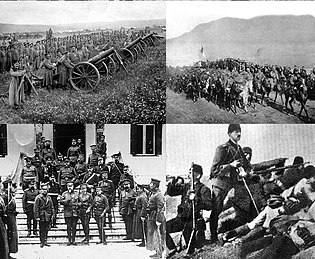| First Balkan War | |||||||||
|---|---|---|---|---|---|---|---|---|---|
| Part of the Balkan Wars | |||||||||
 Clockwise from top right: Serbian forces entering the town of Mitrovica; Ottoman troops at the Battle of Kumanovo; Meeting of the Greek king George I and the Bulgarian tsar Ferdinand I in Thessaloniki; Bulgarian heavy artillery | |||||||||
| |||||||||
| Belligerents | |||||||||
| Commanders and leaders | |||||||||
| |||||||||
| Strength | |||||||||
| Casualties and losses | |||||||||
Total: 156,139 killed, wounded, or died of disease |
| ||||||||
| Numerous Albanian and Ottoman civilian casualties (see below...) | |||||||||
The First Balkan War lasted from October 1912 to May 1913 and involved actions of the Balkan League (the Kingdoms of Bulgaria, Serbia, Greece and Montenegro) against the Ottoman Empire. The Balkan states' combined armies overcame the initially numerically inferior (significantly superior by the end of the conflict) and strategically disadvantaged Ottoman armies, achieving rapid success.
The war was a comprehensive and unmitigated disaster for the Ottomans, who lost 83% of their European territories and 69% of their European population.[10] As a result of the war, the League captured and partitioned almost all of the Ottoman Empire's remaining territories in Europe. Ensuing events also led to the creation of an independent Albania, which dissatisfied the Serbs. Bulgaria, meanwhile, was dissatisfied over the division of the spoils in Macedonia and attacked its former allies, Serbia and Greece, on 16 June 1913, which provoked the start of the Second Balkan War.
During the war, many civilians, overwhelmingly Muslim Turks, were either killed or forced to flee their homes. The highly politicized and disorganized units of the Ottoman army were quite incapable of evacuating the civilians in the war zone. This situation left many civilians in the occupied areas defenseless against the invading armies of the Balkan League. Although there are discussions about the exact amount of civilian casualties, when the war ended great changes occurred in the demographic makeup of the Balkan region.[11]
- ^ Hall 2000, p. 16
- ^ Dennis, Brad (3 July 2019). "Armenians and the Cleansing of Muslims 1878–1915: Influences from the Balkans". Journal of Muslim Minority Affairs. 39 (3): 411–431. doi:10.1080/13602004.2019.1654186. ISSN 1360-2004. S2CID 202282745.
- ^ Hall 2000, p. 18
- ^ Erickson 2003, p. 70
- ^ Erickson 2003, p. 69.
- ^ Erickson 2003, p. 52.
- ^ a b c Hall 2000, p. 135
- ^ Βιβλίο εργασίας 3, Οι Βαλκανικοί Πόλεμοι, ΒΑΛΕΡΙ ΚΟΛΕΦ and ΧΡΙΣΤΙΝΑ ΚΟΥΛΟΥΡΗ, translation by ΙΟΥΛΙΑ ΠΕΝΤΑΖΟΥ, CDRSEE, Thessaloniki 2005, p. 120, (Greek). Retrieved from http://www.cdsee.org
- ^ a b Erickson 2003, p. 329
- ^ Balkan Savaşları ve Balkan Savaşları'nda Bulgaristan, Süleyman Uslu
- ^ "1.1. The ethnography and national aspirations of the Balkans". macedonia.kroraina.com.